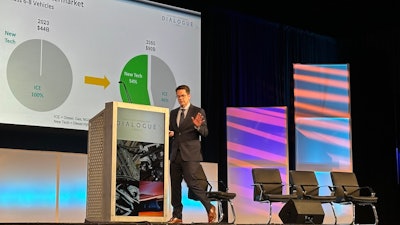
Dave Kalvelage says a forecast out to 2050 is bound to be wrong, but it is a way to get people thinking. Especially about alternative fuels and powertrains, where options abound and the way forward can look, at best, muddy.
"This is a pretty plausible forecast for the different powertrains," Kalvelage says. "We know it's a lot of what-ifs, but it's something to get you thinking about the future."
Derek Kaufman is a managing partner in Schwartz Advisors. He presented a forecast that sees a mixed outlook for powertrains along with Kalvelage's analysis Monday at the Heavy Duty Aftermarket Dialogue ahead of Heavy Duty Aftermarket Week in Dallas.
"We get it," he says. "The EPA/CARB hate fossil fuels. But we think the BET/EV solutions they're pushing outstrips the infrastructure."
Kaufman says some California dealerships may see up to a 90% drop in trucks sold this year over last. Dealers just don't have the trucks on the lot to sell that can meet the regulations.
Here are some of what Kalvelage and Kaufman see in heavy duty's future.
2030
Battery electric trucks will comprise up to 10% of the market by 2030, Kaufman says. "That's more in keeping with infrastructure's availability to support it," he says.
Kaufman also sees battery manufacturers coming back to the U.S., even though the materials will still come from China. Artificial intelligence will be a part of diagnostics and other software, and over-the-air updates and wireless inspection will be available.
The vast majority — 97.6% — of engines will still be internal combustion, even though renewables will ultimately beat biodiesel as the years march toward 2040.
Kalvelage says the aftermarket will be worth $53 billion by 2030, figuring in a 2% inflation rate and conventional parts, even on the alternative powertrain trucks.
2040
The aftermarket by 2040 will be $76 billion, Kalvelage says.
"Usage of traditional fossil fuel diesel is now down to 33%," he noted. Kaufman says there will be a little bit over everything in the marketplace, with battery electric trucks pushing 30% of the market. Battery swapping will be the key to success for many fleets, he says.
"The beauty of battery swapping is the used truck is sold without a degraded battery and therefore without a degraded value," Kaufman says.
Throughout the decade, Kaufman predicts hydrogen becoming a competitive part of the market. Truck OEMs will start buying their customers and automated vehicle sales may go up to 11.7%. Blockchains will be instrumental in tracking sustainability.
"We're going to track every mineral that goes into every component, track that component into the plant, into the vehicle," Kaufman says. "Every stakeholder along the line has full transparency to the life of that product."
2050
By 2050, internal combustion engines will be down to just under 70% of the market. Battery electric will have 30% and autonomous 5%. Cabs will disappear on autonomous trucks, batteries will be smaller, stronger solid state models. Hydrogen will be a long-haul reality.
The aftermarket will be $90 billion and diesel parts will account for just 10% of it, MacKay predicts.
"You know where your company is today. You know where your product lines are. You probably have a strategy for the immediate future," Kalvelage says. "But is it the right strategy? What tech are you going to go with? What are you going to get rid of? How are you going to react to new technologies in the future? Government mandates?"
Kaufman says he's been in the heavy-duty industry for 40 years. The industry is struggling to make sustainability mandates from the government a reality.
"Government oversight can become government overreach pretty quickly," he says. "I think it's time to stand up. Give us the opportunity to get renewables in place. Climate sustainability requires business sustainability."









